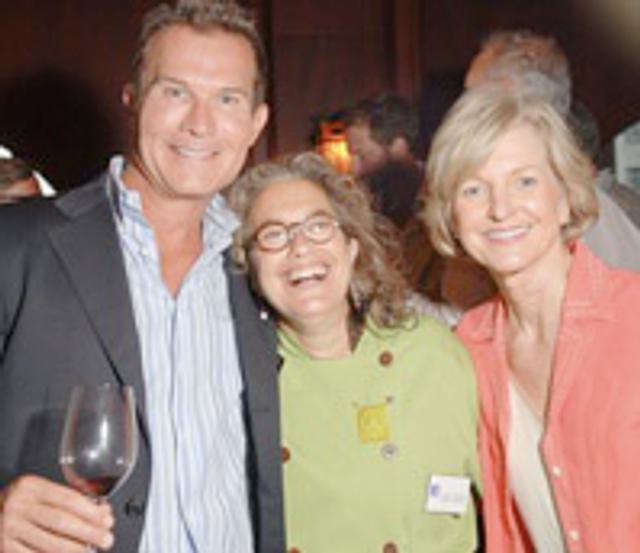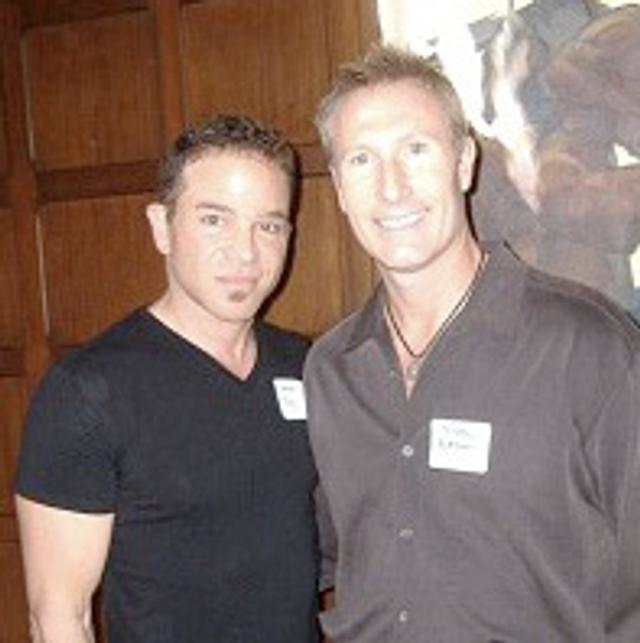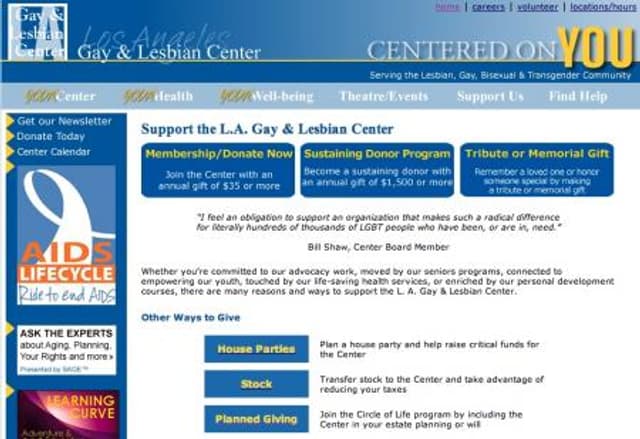LA Gay and Lesbian Center: legacy leadership campaign
- Exhibited by
- SOFII
- Added
- June 20, 2012
- Medium of Communication
- Target Audience
- Legacy, planned gift
- Type of Charity
- Country of Origin
- USA
- Date of first appearance
- September, 2000
SOFII’s view
The LA Gay and Lesbian Center might have been a little slow at looking for legacy prospects, but when they got started they really showed how it should be done. The first thing they did was to identify those donors who were passionate about the Center and the rest just fell into place, with remarkable results.
Creator / originator
Rich Fox FRSA, CEO of Rich Fox & Associates, Inc and Joel Safranek of the LA Gay and Lesbian Center.
Summary / objectives
To move as many supporters as possible to include the Center in their wills and estate plans and to maximise the amount of legacy money committed to the Center.
Background
Over the years, the LA Gay and Lesbian Center had often been surprised when they received bequests, even large ones. Many people who had left them hadn't notified the organisation in advance and a large number didn't even appear on the organisation's donor file. Most of those who were there did not, at first glance, seem to be the kind of people who would leave any bequest to the Centre, let alone a large one.
It occurred to the staff at the Center that there were many people who felt passionately about the organisation, yet they didn't know who they were. It also seemed likely that these passionate supporters probably had certain attributes in common, which once discovered could help the Center to identify these valuable supporters.
Once they found them, they could cultivate them so that they might increase the amount of their legacy. It would also allow the organisation to develop irrevocable trusts and possible outright major gifts.
More importantly, there were probably many others who possessed almost all the same attributes, but who were not leaving bequests to the Center. They also felt passionately about the organisation's mission and they, too, might leave a bequest if properly identified, motivated and then cultivated in a personal, one-to-one manner.
So the Center embarked on a legacy leadership programme to identify, motivate and cultivate not only those who would think to leave them a legacy in their will, but also those who, without their help, would not.
A key factor in the subsequent success of the programme was the Center's committed volunteer leadership who saw the enormous potential for legacy giving and supported the programme from the start. First and foremost in this was the former board chair, Duke Comegys, who personally laid the foundation for the planned giving programme and promoted it as a volunteer for many years, ultimately leaving approximately $3 million to the Center himself.
Special characteristics
There is an expression used in Britain to describe the most effective relationship-building fundraising – 'softly, softly', which as you might guess, means not overly aggressive, nor pushy.
In developing this programme, the Center always tried to remember this. They were not only trying to convince people to include the Center in their will, rather they were trying to find people who already loved the organisation, to show them that there was another way that they could help it to achieve the shared vision for its mission and future.
Influence / impact
This case study demonstrated that by using direct mail and telephone in a soft, relationship-building manner, followed by very personal, one-to-one cultivation, extremely large amounts of legacy commitments could be obtained. This was one of the first such approaches in the US and one of the most successful ever.
Details
The campaign consisted of six phases.
1. Targeting.
Because the Center did not have a very large list of donors, they did not have a sufficient number of prospects to fine tune their targeting as much as they would have liked. So, for the initial test group they simply selected a cross section of donors for whom they had addresses and telephone numbers, and who had made at least one gift in the past 12 months.
They then took out certain people such as major donors, board members, previously identified prospects, 'do not calls', 'do not mails', etc.
When they finished the initial campaign, they tested the programme again, selecting only those donors who had already committed to open-ended, monthly giving to the Center.
2.Opt-out pre-letter.
To begin the programme, we sent a direct mail package, which contained an 'opt-out' letter.
This 'softly, softly' letter, thanked donors for their lifetime support and explained the organisation's need for bequests and other estate gifts. The letter reminded prospects that many people don't like to think about writing a will and so, despite their best intentions, they often don't adequately ensure that their wishes will be carried out.
As well stressing that this was not a request for another contribution, the letter introduced the Circle of Life and explained that to join donors don't have to declare how much they intend to leave the organisation, but only that they intend to definitely include the organisation in their estate plans. The letter referred to an enclosed enrolment form, which also included an opt-out box for prospects to let the Center know they were not interested and did not wish to be called.
The letter explained that when the organisation received a signed enrolment form, the donor's name would be prominently displayed as a member of the Circle of Life. Unless the donor wanted to remain anonymous, the name would be inscribed on the wall in the lobby of a Center building, published in the Center's annual report and the anniversary gala journal in order to motivate others to follow the example.
Finally, the letter pointed out that the legacy programme is so important to the organisation's future that someone would call soon to explain the programme further and answer any questions – unless the donor returned the enrolment form to indicate whether or not they would participate.
For the pre-letter package, a first-class, multi-page, single-sided, personalised letter, the pledge form (with opt-out option) and a reply envelope were included.
3. Very soft service call.
Next we called those prospects who hadn't responded within three weeks of receiving the initial mailing. The caller reminded them about the letter they had recently received and said that the call was to explain the programme further and to answer any questions they might have.
Prospects were also reminded that the size of bequest wasn't the most important thing; what was important was setting an example for others to follow. The caller explained that they could participate and still remain anonymous; and that when they signed the enrolment form, they would be sent more detailed information, including the correct language to incorporate into their will and a helpline number to call with any further questions.
Finally they were asked if they had any questions and if they might consider participating.
4. An immediate thank-you package to those who enrolled.
Those who said 'yes' or 'maybe' were sent a thank-you letter and enrolment form the next day along with an example of the language needed in a codicil to include the Center in their will.
This package also included information about the value and benefits of other kinds of planned gifts, such as irrevocable charitable remainder trusts. The letter also provided a helpline phone number and name of a person whom prospects, or their lawyers, could call with any questions.
5. Very soft reminder packages and telephone call.
To encourage the broadest possible participation, we directed a series of soft reminders at those prospects who said yes but hadn't yet returned their enrolment forms. The series consisted of a third enrolment form and covering letter, about four weeks after the first telephone call and another reminder package four weeks after that.
Four weeks later still, the prospect received a very, very soft reminder call and a follow-up enrolment package was sent to those who pledged again.
6. Cultivation and bonding.
Once the form was returned, Joel Safranek of the Center provided ongoing, personal follow-up for all those who signed up as members of the circle of life.
He met them in person to thank them and to ask if any further information would be useful. He also invited them to regular luncheons of the Circle of Life. He asked if they were interested in learning more about other forms of planned gifts, such as charitable remainder trusts or charitable gift annuities, and if their lawyers found the bequest language helpful.
Most importantly, he developed a personal ongoing relationship with them and effectively cultivated each of them for the following 10 years.
Costs
Over the 10 years of the programme, the total costs represent less than one per cent of the value of the bequest (legacy) commitments. No dedicated planned giving staff was hired and the Center was able to secure experienced pro bono counsel to help in discussions with prospects regarding estate-planning options.
Results
The results were truly outstanding. The first test, to a cross section of current donors to the Center, produced this initial response:
- One per cent committed to an estate gift in response to the letter.
- Five per cent more committed to an estate gift in response to the call.
- Thirty per cent more indicated that they were seriously considering an estate gift.
For the second test, to monthly givers to the Center, the results were better still:
- Three and a half per cent committed to an estate gift in response to the letter.
- Eleven per cent more committed to an estate gift in response to the call.
- Twenty-two per cent more indicated that they were seriously considering an estate gift.
More importantly, thanks to the effective personal, one-to-one follow-up over the next 10 years, the LA Gay and Lesbian Center has now obtained distributed estate gifts and irrevocable commitments totalling over $10,000,000.
Merits
This programme represents a rare instance in which cutting edge direct mail and telephone marketing were used in close coordination with the very best of classic cultivation and stewardship techniques for major gift development, which produced an extraordinarily successful legacy programme.

























